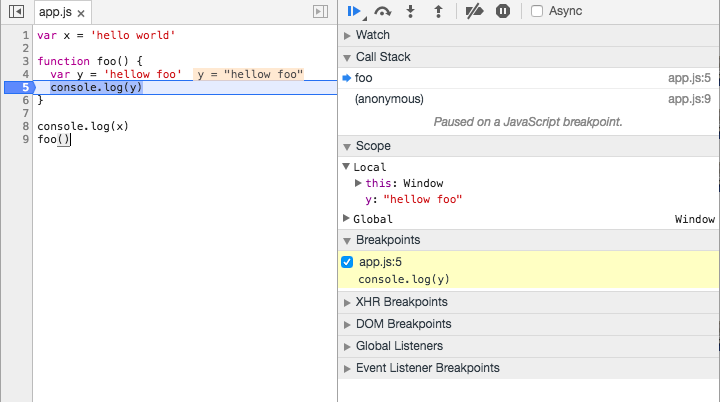JS the Hardcore: 执行上下文(Execution Context)
先看个例子:
console.log(a)
console.log(foo())
var a = 'hello world'
function foo() {
console.log('foo')
}
估计大部分人早就对这种问题了如指掌了,输出结果也是脱口而出:
undefined 'foo'
请解释一下原因?
这不就是常说的 Hoisting 吗?
代码在执行的时候,其实是这个样子的:
function foo() {
console.log('foo')
}
var a
console.log(a)
console.log(foo())
a = 'hello world'
是的,这样解释也可以,但是不够准确。如果仅仅理解到这个层面,而不把这里面涉及到的「执行上下文」(Execution Context, 下面简称 EC)这个概念弄明白,还是不能「知其所以然」。
首先需要澄清的一点是,像 C 和 Java 这类所谓的「静态语言」需要编译后才能运行,但其实 Javascript 一样也是有编译过程的, 只是处于一些限制,编译过程特别快(以微秒计),以至于感觉上 Javascript 代码好像并没有经过编译。
当需要向别人描述一件事情的经过时,往往需要把事情的前因后果以及与其相关的场景预先说明一下。 类似,EC 就是一段代码涉及到的场景,在代码运行之前,js engine 会做一些变量内存分配,代码上下文关联的准备工作,这就是 EC。 EC 是 Javascript 引擎实现的一个内部机制,不能在代码中直接访问到。
对编程语言来说,给变量赋值,获取变量的值,是需要解决的基本问题,Javascript 当然也不例外。 EC 中会给变量分配一个存储空间,与之对应的数据结构称作 enviroment。
当程序流程需要从当前的 EC 进入另外一个和当前上下文无关的代码片段时,会创建一个新的 EC,并被推入栈中。这就是「执行上下文栈」(Execution Context Stack),可以看作是 调用栈的镜像。由于所有的 js 代码都存在于全局环境中,所以首先会创建 「全局执行上下文」(Global Execution Context) ,除此之外,js 中每一次的函数调用也会生成 EC,所以栈底肯定会是 全局执行上下文。
如果把 EC 视为作一个抽象对象,那这个对象包含了代码相关的 this、enviroment(存储标识符包括变量声明、函数声明、函数表达式的数据结构)和一个指向外部 enviroment 的指针。
Global Execution Context
Global Execution Context = {
global object,
this: global object,
outer environment: null,
enviroment: {
// all the identifiers
variable,
function expression,
function declaration,
},
}
Function Execution Context
Execution Context = {
this: some value,
outer environment: outer lexcial environment,
enviroment: {
// all the identifiers
parameter,
arguments,
variable,
function expression,
function declaration,
},
}
在 EC 创建之后,js engine 会开始顺序执行代码。
/** 01 **/ var x = 'hello world'
/** 02 **/
/** 03 **/ function foo() {
/** 04 **/ var y = 'hellow foo'
/** 05 **/ console.log(y)
/** 06 **/ }
/** 07 **/
/** 08 **/ console.log(x)
/** 09 **/ foo()
代码执行前,首先创建全局执行上下文并设置为 「当前执行上下文」(running execution context) :
Execution Context = {
global object,
this: global object,
outer environment: null,
enviroment: {
x: undefined,
foo,
bar,
},
}
之后,顺序执行代码,执行到 ln 01 时,给变量 x 赋值,
Global Execution Context = {
global object,
this: global object,
outer environment: null,
enviroment: {
x: 'hello world',
foo,
bar,
},
}
代码执行到 ln 08 时,需要去 enviroment 中寻找 x 的值,此时为 'hello world' 。
代码执行到 ln 09 时,因为是对函数的调用,会创建一个新的执行上下文,并置为「当前执行上下文」:
foo Execution Context = {
this: window,
outer environment: Global.environment,
enviroment: {
arguments,
y: undefined,
bar,
},
}
然后代码继续执行,到 ln 04 时,有对 y 的赋值操作,此时
foo Execution Context = {
this: window,
outer environment: Global.environment,
enviroment: {
arguments,
y: 'hello foo',
},
}
代码执行到 ln 05 有对 y 的取值操作,y 值在当前的 enviroment 中为 'hellow foo' 。
EC 栈的情况,可以参照下图「调用栈」(Call Stack)的状态:

到这里就基本上把执行上下文的一些基本概念讲完了,其中涉及到的一些内容目前不理解没有关系,后面会慢慢解释。











![[HBLOG]公众号](https://www.liuhaihua.cn/img/qrcode_gzh.jpg)

